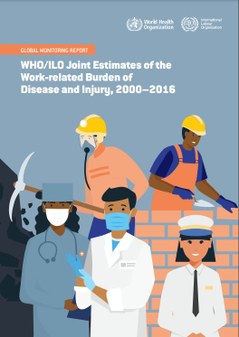Nordic vision zero for workplace accidents inspires world congress
The Nordics have considerable influence in the international debate on work environments. That was also evident during the 22nd world congress on work environments and security, held from 20 - 23 September in Toronto, Canada.
This year’s conference was hosted by Canada, the International Labour Organisation ILO and the International Social Security Association (ISSA) – the world’s leading international organisation for social security institutions, government departments and agencies.
The conference focused on how to prevent workplace accidents and occupational ill health – or as the programme put it; “Prevention in the Connected Age: global solutions to achieve safe and healthy work for all”.
ISSA has a vision zero for no workplace injuries or illnesses, which the association presented at the conference.
“Vision Zero is an idea that emerged in Sweden on road safety. That was in the 90s, where the possibility of having zero road accidents was raised. From there it was slowly but surely translated and integrated into the world of work,” Bernd Treichel, an expert on prevention work at ISSA and one of the conference organisers, told the Human Resources Director magazine.

Guy Ryder, Vera Paquete-Perdigão , bägge ILO samt Bernd Treichel, ISSO, var bland talarna på kongressen. Foto: XXII World Congress on Safety and Health.
The Nordic contribution was not as prominent as during the previous conference in Singapore, but the Nordic work environment authorities’ joint report “Work Today and in the Future”, which the NLJ has written about in the past, was presented at a pre-conference fringe event, attended by the ILO Secretary-General Guy Ryder.
“During the ILO’s centenary year of 2019, we presented a wide-ranging report on the future of work, and then Covid-19 brought the future to us in a way and at a speed which we had no chance to foresee,” said Guy Ryder.
"At the right time"
He said the Nordic report came “at the right time since it raised issues that have been a focus over the past few months”.
The Nordic report was published one year ago, in September 2020, and contains an entire chapter about pandemics. It is coloured by the fact that in the beginning there was a major lack of personal protection equipment, PPE, for people working with infected people. The report warns the race to approve new products must not lead to a lowering of quality standards.
“Thus, market surveillance of PPE and other safety equipment remains an area of critical concern for occupational safety and health in times of pandemics. Labour inspectors today are far from equipped to handle situations of this magnitude, and their pandemic preparedness is likely an area that needs both more attention and investment moving forward.”
One of the report’s 72 points of advice is to:
“Initiate collaborations with national emergency preparedness agencies so that occupational safety and health aspects are considered fundamental in planning in the local, national, and global emergency preparedness plans.”
The pandemic has also led to a big increase in remote working.
“As the risks of working from home are well known, the labour inspectors need to follow closely what this might entail in the long run for occupational safety and health, OSH, and work-life balance for the workers, and the employers’ OSH responsibility in the workers’ private homes.”
When it comes to remote working, the advice given to Nordic work environment authorities is to:
“Develop a framework – based on evaluations – for pragmatic home office OSH regulations for long-term or permanent work from home. Special attention should be paid to employers’ responsibility while regulating workspaces in the workers' home and still ensuring the privacy of the workers.”
Another effect of the Corona pandemic is how certain businesses, like home delivery firms, experienced a positive outcome. Meanwhile, new platform economy employers rarely take responsibility for the people working for them. The ILO recently published a comprehensive report on atypical work, which was presented by Uma Rani Amara during the fringe event.

Uma Rani Amana, ILO. Photo: YouTube
“The platform companies create new jobs, but they are making the border between employment and self-employment harder to see,” she said.
Globally, so far, two types of businesses are behind most of the turnover – taxi operators like Uber and restaurant food home delivery services like Foodora.
This is a breakdown of the turnover for the different platform companies:

Foodora is owned by Delivery Hero, and Chinese Meituan is also a home delivery company. Uber also serves the home delivery market under the brand Uber Eats.
“82% of taxi or home delivery drivers say they work more than normal hours,” said Uma Rani Amara.
The ILO’s report is based on surveys conducted among 12,000 workers across 85 different companies. The ILO has also mapped different legislation which has been introduced and agreements between platform businesses and workers.
“It is not enough to simply solve national problems. What we need is a coordinated, international pulling together, where one aim should be to secure collective negotiation rights for platform workers,” said Uma Rani Amara, who coordinated the report and was one of the lead authors.
The final discussion explored on what level work environment issues can best be addressed. Taking part in this debate were Stefan Olsson from the EU, the ILO’s Vera Paquete-Perdigão and Monica Seem from the Norwegian Labour Inspection Authority.
“In this very fast-changing environment we need to be sure that we take the decisions at the right level,” said Stefan Olsson, director at the DG for Employment, Social Affairs and Inclusion at the European Commission.

Stefan Olsson, archive image: EU-OSHA
“What will the member states do, what will the social partners do and what will be done at the EU level? It would be very dangerous if it is perceived that if the EU doesn’t tackle this no one else will. In the Nordic concept, this would naturally be for the national social dialogue, and we have to have a participative process because we cannot sit and wait for the EU legislation – that will take too long,” said Stefan Olsson.
One problem is the fact that EU legislation is very much focused on employees and employers. As soon as you move outside of those concepts, joint EU legalisation no longer applies, he pointed out.
Vera Paquete-Perdigão, who is the Director of the Governance and Tripartism Department at the ILO, has been working on the first joint report that the ILO and the World Health Organisation have produced, looking at how many workers die every year in workplace accidents or from work-related illnesses.

The results were presented on 16 September this year and showed that 1.9 million people died in 2016 due to the 19 different occupational risks which the two organisations focused on in their report. The largest risk factors were long working hours, which led to 750,000 deaths, and air pollution in the workplace, which led to 450,000 deaths.
Between 2000 and 2016, the number of deaths fell by 14%, but there was an increase in coronary disease and strokes linked to long working hours – 41% and 19% respectively.
“We must reassert the gains we have made on traditional OSH challenges, like work-related cancers, accidents, musculoskeletal and psychosocial disorders. We cannot lose sight of these traditional OSH issues and must see to it that we consolidate these gains as we move forward and tackle new and emerging risks,” said Monica Seem at the Norwegian Labour Inspection Authority.
The Congress program features over 200 speakers in six technical sessions and 21 symposia.



 Follow us on Facebook
Follow us on Facebook
